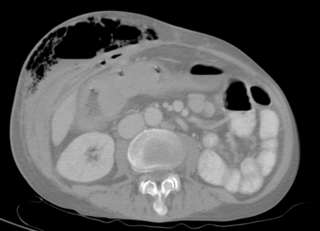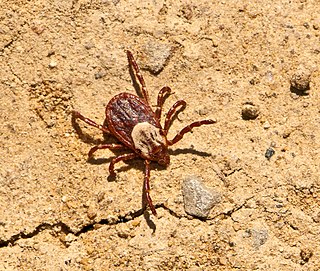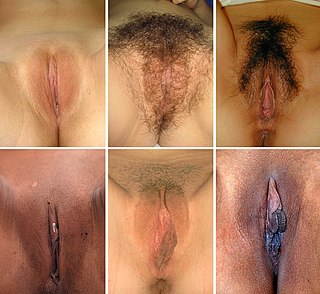
In mammals, the vagina is the elastic, muscular part of the female genital tract. In humans, it extends from the vestibule to the cervix. The outer vaginal opening is normally partly covered by a thin layer of mucosal tissue called the hymen. At the deep end, the cervix bulges into the vagina. The vagina allows for sexual intercourse and birth. It also channels menstrual flow, which occurs in humans and closely related primates as part of the menstrual cycle.

A fistula in anatomy is an abnormal connection between two hollow spaces, such as blood vessels, intestines, or other hollow organs. Types of fistula can be described by their location. Anal fistulas connect between the anal canal and the perianal skin. Anovaginal or rectovaginal fistulas occur when a hole develops between the anus or rectum and the vagina. Colovaginal fistulas occur between the colon and the vagina. Urinary tract fistulas are abnormal openings within the urinary tract or an abnormal connection between the urinary tract and another organ such as between the bladder and the uterus in a vesicouterine fistula, between the bladder and the vagina in a vesicovaginal fistula, and between the urethra and the vagina in urethrovaginal fistula. When occurring between two parts of the intestine, it is known as an enteroenteral fistula, between the small intestine and the skin as an enterocutaneous fistula, and between the colon and the skin as a colocutaneous fistula.

Sexual penetration is the insertion of a body part or other object into a body orifice, such as the mouth, vagina or anus, as part of human sexual activity or animal sexual behavior.

The Vagina Monologues is an episodic play written in 1996 by Eve Ensler which developed and premiered at HERE Arts Center, Off-Off-Broadway in New York and was followed by an Off-Broadway run in at Westside Theatre. The play explores consensual and nonconsensual sexual experiences, body image, genital mutilation, direct and indirect encounters with reproduction, vaginal care, menstrual periods, prostitution, and several other topics through the eyes of women with various ages, races, sexualities, and other differences.
A pessary is a prosthetic device inserted into the vagina for structural and pharmaceutical purposes. It is most commonly used to treat stress urinary incontinence to stop urinary leakage and to treat pelvic organ prolapse to maintain the location of organs in the pelvic region. It can also be used to administer medications locally in the vagina or as a method of contraception.

The female reproductive system is made up of the internal and external sex organs that function in the reproduction of new offspring. In humans, the female reproductive system is immature at birth and develops to maturity at puberty to be able to produce gametes, and to carry a fetus to full term. The internal sex organs are the vagina, uterus, fallopian tubes, and ovaries. The female reproductive tract includes the vagina, uterus, and fallopian tubes and is prone to infections. The vagina allows for sexual intercourse and childbirth, and is connected to the uterus at the cervix. The uterus or womb accommodates the embryo which develops into the fetus. The uterus also produces secretions which help the transit of sperm to the fallopian tubes, where sperm fertilize ova produced by the ovaries. The external sex organs are also known as the genitals and these are the organs of the vulva including the labia, clitoris, and vaginal opening.

Vaginoplasty is any surgical procedure that results in the construction or reconstruction of the vagina. It is a type of genitoplasty. Pelvic organ prolapse is often treated with one or more surgeries to repair the vagina. Sometimes a vaginoplasty is needed following the treatment or removal of malignant growths or abscesses in order to restore a normal vaginal structure and function. Surgery to the vagina is done to correct congenital defects to the vagina, urethra and rectum. It will correct protrusion of the urinary bladder into the vagina (cystocele) and protrusion of the rectum (rectocele) into the vagina. Often, a vaginoplasty is performed to repair the vagina and its attached structures due to trauma or injury. Labiaplasty, which alters the appearance of the vulva, can be performed as a discrete surgery, or as a subordinate procedure within a vaginoplasty.

Semen collection refers to the process of obtaining semen from human males or other animals with the use of various methods, for the purposes of artificial insemination, or medical study. Semen can be collected via masturbation, prostate massage, artificial vagina, penile vibratory stimulation (vibroejaculation) and electroejaculation. Semen can be collected from endangered species for cryopreservation of genetic resources.

Fingering is typically the use of fingers or hands to sexually stimulate the vulva or vagina. Vaginal fingering is legally and medically called digital penetration or digital penetration of the vagina. Fingering may also include the use of fingers to sexually stimulate the anus.

Vaginectomy is a surgery to remove all or part of the vagina. It is one form of treatment for individuals with vaginal cancer or rectal cancer that is used to remove tissue with cancerous cells. It can also be used in gender affirmation surgery. Some people born with a vagina who identify as trans men or as nonbinary may choose vaginectomy in conjunction with other surgeries to make the clitoris more penis-like (metoidioplasty), construct of a full-size penis (phalloplasty), or create a relatively smooth, featureless genital area.
Canine reproduction is the process of sexual reproduction in domestic dogs, wolves, coyotes and other canine species.

"Sunday" is a song by American alternative rock band Sonic Youth. It was released in 1998 by record label Geffen as the first and only single from their 10th studio album, A Thousand Leaves.
Vaginal cancer is an extraordinarily rare form of cancer that develops in the tissue of the vagina. Primary vaginal cancer originates from the vaginal tissue – most frequently squamous cell carcinoma, but primary vaginal adenocarcinoma, sarcoma, and melanoma have also been reported – while secondary vaginal cancer involves the metastasis of a cancer that originated in a different part of the body. Secondary vaginal cancer is more common. Signs of vaginal cancer may include abnormal vaginal bleeding, dysuria, tenesmus, or pelvic pain, though as many as 20% of women diagnosed with vaginal cancer are asymptomatic at the time of diagnosis. Vaginal cancer occurs more frequently in women over age 50, and the mean age of diagnosis of vaginal cancer is 60 years. It often can be cured if found and treated in early stages. Surgery alone or surgery combined with pelvic radiation is typically used to treat vaginal cancer.

Teeth is a 2007 American comedy horror film written and directed by Mitchell Lichtenstein. The film stars Jess Weixler and was produced by Lichtenstein on a budget of $2 million. The film premiered at the Sundance Film Festival on January 19, 2007, and received a limited release in the United States on January 18, 2008, by Roadside Attractions. Its title refers to the ancient trope of vagina dentata.

Dermacentor is a genus of ticks in the family Ixodidae, the hard ticks. The genus has a cosmopolitan distribution, with native species on all continents except Australia. Most occur in the Nearctic realm.

The vulva consists of the external female sex organs. The vulva includes the mons pubis, labia majora, labia minora, clitoris, vestibular bulbs, vulval vestibule, urinary meatus, the vaginal opening, hymen, and Bartholin's and Skene's vestibular glands. The urinary meatus is also included as it opens into the vulval vestibule. Other features of the vulva include the pudendal cleft, sebaceous glands, the urogenital triangle, and pubic hair. The vulva includes the entrance to the vagina, which leads to the uterus, and provides a double layer of protection for this by the folds of the outer and inner labia. Pelvic floor muscles support the structures of the vulva. Other muscles of the urogenital triangle also give support.

Hokkien is one of the largest Chinese language groups worldwide. Profanity in Hokkien most commonly involves sexual references and scorn of the object's ancestors, especially their mother. The mentioning of sexual organs is frequently used in Hokkien profanity.

German submarine U-1201 was a Type VIIC U-boat of Nazi Germany's Kriegsmarine during World War II.
Gleimia europaea is a bacterium from the genus Gleimia. Gleimia europaea can cause cases of bacteraemia in very rare cases. Gleimia europaea is formerly known as Actinomyces europaeus. It comes from the domain of gram-positive actinobacteria.

Canadian Pacific 1201 is a 4-6-2 Pacific steam locomotive. Built by the Canadian Pacific Railway's Angus shops in Montreal, Quebec, in 1944, No. 1201 was used to pull passenger trains across Ontario and Quebec. After the Canadian Pacific removed the locomotive from service, the railway put the No. 1201 in storage at the Angus shops yard, and it was donated to the Canada Science and Technology Museum six years later. In 1973, No. 1201 was removed from the museum to be restored to operating condition. Subsequently, No. 1201 pulled a variety of excursion trains and participated in a variety of special events, such as the Canadian Pacific centennial of 1985 and the 1986 Steam Exposition. As of 2022, No. 1201 is stored out of service at the Canada Science and Technology Museum in Ottawa. It is the oldest survivor of the Canadian Pacific's G5 class locomotives, and the last remaining locomotive of two prototypes of the class to be preserved.














